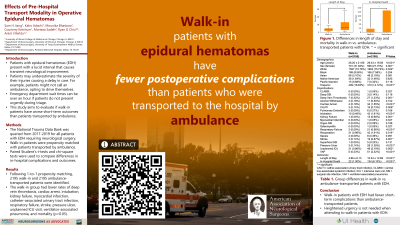Effects of Pre-Hospital Transport Modality in Operative Epidural Hematomas
Effects of Pre-hospital Transport Modality in Operative Epidural Hematomas
Friday, April 21, 2023


Sam H. Jiang, BS (he/him/his)
Medical Student
University of Illinois College of Medicine at Chicago
Chicago, Illinois, United States
ePoster Presenter(s)
Introduction: Patients with epidural hematomas (EDH) classically present with a lucid interval (LI), which involves a complete temporary improvement following the initial loss of consciousness. This improvement may be perceived as a resolution of symptoms, causing a delay in seeking care which ultimately leads to possible worse immediate outcomes. The purpose of this study is to evaluate whether EDH patients who walk into the emergency department (ED) have worse short-term outcomes compared to patients who are transported by emergency medical services (EMS).
Methods: The National Trauma Data Bank was queried from 2017-2019 for all patients with epidural hematomas requiring neurological surgery. Patients who transported themselves to the emergency department were propensity matched with patients who were transported to the ED by EMS based on demographics, pre-existing comorbidities, and Abbreviated Injury Scale severity scores. Paired Student’s t-tests and chi-square tests were used to compare differences in in-hospital complications and outcomes between the two groups. Benjamini-Hochberg multiple comparison’s correction was performed. Alpha was set to 0.05.
Results: Following 1-to-1 propensity matching, 2195 walk-in and 2195 EMS-transported patients were identified. The walk-in group had lower rates of deep vein thrombosis, cardiac arrest, intubation, kidney failure, myocardial infarction, catheter-associated urinary tract infection, respiratory failure, stroke, pressure ulcer, unplanned ICU visit, ventilator-associated pneumonia, and mortality (p < 0.05). There were no significant differences in rates of infection and reoperation between the two groups.
Conclusion : Patients with EDH arriving at the emergency department by walk-in had fewer in-hospital complications than patients transported by EMS after controlling for patient comorbidities and injury severity. As such, providers need not have a heightened level of urgency when attending to walk-in patients presenting to the ED with EDH. Further research is warranted to better understand the differences in postoperative outcomes between these two groups.
Methods: The National Trauma Data Bank was queried from 2017-2019 for all patients with epidural hematomas requiring neurological surgery. Patients who transported themselves to the emergency department were propensity matched with patients who were transported to the ED by EMS based on demographics, pre-existing comorbidities, and Abbreviated Injury Scale severity scores. Paired Student’s t-tests and chi-square tests were used to compare differences in in-hospital complications and outcomes between the two groups. Benjamini-Hochberg multiple comparison’s correction was performed. Alpha was set to 0.05.
Results: Following 1-to-1 propensity matching, 2195 walk-in and 2195 EMS-transported patients were identified. The walk-in group had lower rates of deep vein thrombosis, cardiac arrest, intubation, kidney failure, myocardial infarction, catheter-associated urinary tract infection, respiratory failure, stroke, pressure ulcer, unplanned ICU visit, ventilator-associated pneumonia, and mortality (p < 0.05). There were no significant differences in rates of infection and reoperation between the two groups.
Conclusion : Patients with EDH arriving at the emergency department by walk-in had fewer in-hospital complications than patients transported by EMS after controlling for patient comorbidities and injury severity. As such, providers need not have a heightened level of urgency when attending to walk-in patients presenting to the ED with EDH. Further research is warranted to better understand the differences in postoperative outcomes between these two groups.
